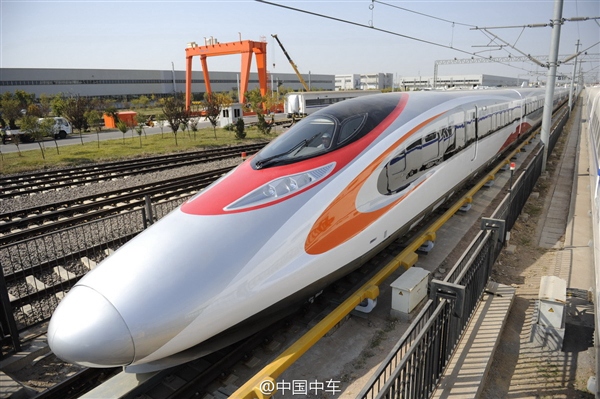


After completing production and extensive testing, the first high-speed trains manufactured by Chinese railway giant CRRC Corporation Ltd. for the Hong Kong Section of a new high-speed railway project arrived in Hong Kong on Sept. 23.
The nine eight-carriage trains, built for the Guangzhou-Shenzhen-Hong Kong Express Rail Link, were manufactured by CRRC Qingdao Sifang Co., Ltd. (Qingdao Sifang) according to a design based on the CRH380A model, said Hong Kong rail operator MTR.
The maximum number of passengers on a CRH380A high-speed train is 556. As Hong Kong opted not to include a business-class section, 23 extra passengers will be able to ride the train, a CRRC employee told Caixin.
The first batch of trains for the Express Rail Link project sailed to Hong Kong via Qingdao. The others will be transported by train, Caixin said. Upon arrival in Hong Kong, the trains will be delivered to the Shek Kong Stabling Sidings. MTR said the trains will then undergo multiple static tests and low-speed dynamic tests. These will be followed by dynamic testing on the 16-kilometer pilot test section.
"During train production, MTR staff is stationed at the factory to closely monitor the process, including manufacturing, assembly and testing. A range of monitoring mechanisms and independent assessments are conducted throughout the process. With decades of expertise and experience, our system ensures that both the materials and production quality are commensurate with international safety standards and national regulations," said Philco Wong, projects director of MTR.
Currently, there is only one Beijing-Kowloon rail, and it takes approximately 23 hours. The Express Rail Link is expected to be put into operation in 2017, Nanfang Metropolis Daily reported.
However, the project’s infrastructure has faced controversy and difficulties since its inception. In December 2015, the Hong Kong government applied for approval from the Legislative Council (Legco) for an extra HK$19.6 billion, on top of the HK$65 billion that lawmakers approved in 2010, Hong Kong-based South China Morning Post reported. Hong Kong's Legco approved the extra funds in March.
 Fire brigade in Shanghai holds group wedding
Fire brigade in Shanghai holds group wedding Tourists enjoy ice sculptures in Datan Town, north China
Tourists enjoy ice sculptures in Datan Town, north China Sunset scenery of Dayan Pagoda in Xi'an
Sunset scenery of Dayan Pagoda in Xi'an Tourists have fun at scenic spot in Nanlong Town, NW China
Tourists have fun at scenic spot in Nanlong Town, NW China Harbin attracts tourists by making best use of ice in winter
Harbin attracts tourists by making best use of ice in winter In pics: FIS Alpine Ski Women's World Cup Slalom
In pics: FIS Alpine Ski Women's World Cup Slalom Black-necked cranes rest at reservoir in Lhunzhub County, Lhasa
Black-necked cranes rest at reservoir in Lhunzhub County, Lhasa China's FAST telescope will be available to foreign scientists in April
China's FAST telescope will be available to foreign scientists in April "She power" plays indispensable role in poverty alleviation
"She power" plays indispensable role in poverty alleviation Top 10 world news events of People's Daily in 2020
Top 10 world news events of People's Daily in 2020 Top 10 China news events of People's Daily in 2020
Top 10 China news events of People's Daily in 2020 Top 10 media buzzwords of 2020
Top 10 media buzzwords of 2020 Year-ender:10 major tourism stories of 2020
Year-ender:10 major tourism stories of 2020 No interference in Venezuelan issues
No interference in Venezuelan issues
 Biz prepares for trade spat
Biz prepares for trade spat
 Broadcasting Continent
Broadcasting Continent Australia wins Chinese CEOs as US loses
Australia wins Chinese CEOs as US loses